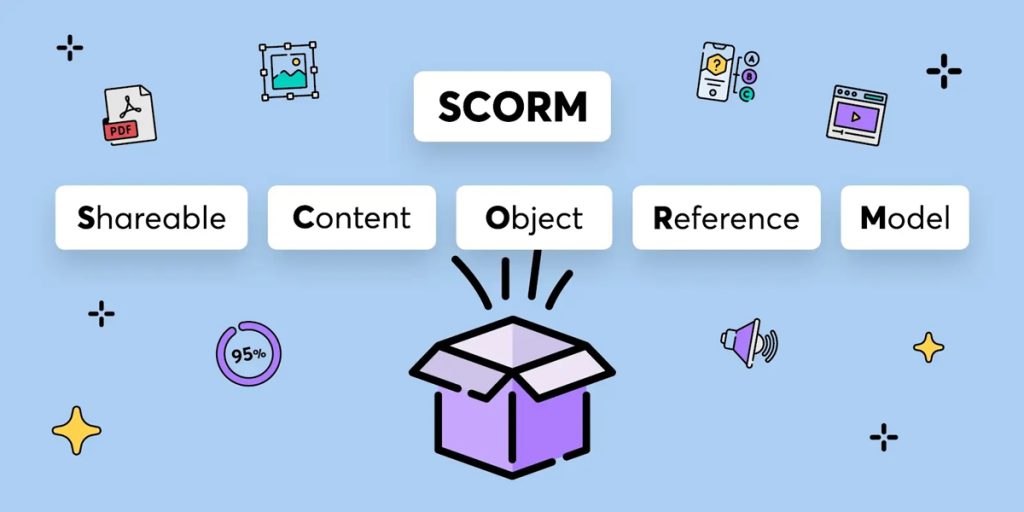SCORM is one of the most talked-about terms in e-learning and corporate learning and development, and many teams are now asking whether SCORM is still relevant in 2025, how it actually works, and what role it should play in their training strategy.
This guide explains what SCORM is, how it ensures compatibility across Learning Management Systems (LMS), why it remains important for corporate training, and how to create SCORM-compliant courses.
What Is SCORM?
SCORM (Sharable Content Object Reference Model) is a set of technical standards for e-learning content. It ensures that online training materials work consistently across any compatible LMS.
For organisations, SCORM delivers confidence that training courses will launch correctly, track learner progress accurately, and maintain a consistent user experience across platforms.
Why SCORM Matters for Corporate Training
Without a standard, content developed for one LMS might fail in another, leading to wasted time and cost.
SCORM solves this problem by defining how learning content should be packaged and communicated. It works much like the USB standard: any compliant device works in any compliant port. Similarly, SCORM-compliant content works in any SCORM-compatible LMS.
Breaking Down the Acronym
Sharable Content Object
Individual learning resources—videos, quizzes, assessments—designed to be reusable across different courses and contexts.
Reference Model
SCORM is not software. It is a framework describing how e-learning content should be structured and how it communicates progress and results with an LMS.
How SCORM Works
- Packaging: Content is exported as a SCORM package—a standardised ZIP file with assets and a manifest describing its structure.
- Launch and Tracking: When uploaded to an LMS, the package uses SCORM commands to track learner progress, scores, and completion.
- Interoperability: Content created in one authoring tool will work in any SCORM-compatible LMS without modification.
Is SCORM Still Relevant in 2025?
While newer standards like xAPI and cmi5 offer advanced features such as detailed analytics and offline tracking, SCORM remains the industry baseline.
Most LMS platforms require SCORM for basic compatibility. Its broad adoption ensures existing content libraries remain usable and valuable. For corporate training teams, SCORM continues to be a reliable, cost-effective way to deliver consistent learning experiences.

How to Create SCORM-Compliant Courses: Step-by-Step
1. Choose an Authoring Tool
Most organisations use dedicated authoring tools that simplify SCORM compliance.
Commercial options include Articulate Storyline and Adobe Captivate. Open-source alternatives include eXeLearning and Xerte.
2. Plan Your Course Content
Define clear learning objectives, structure your modules logically, and choose appropriate media and interactions to ensure an effective learning experience.
3. Design Your Course in the Authoring Tool
Use your chosen tool to build the course. Incorporate text, images, video, quizzes, and interactive elements. Ensure your design adheres to SCORM guidelines so that tracking and bookmarking function correctly.
4. Export as a SCORM Package
Export the course as a SCORM package. This typically generates a ZIP archive containing all assets and the manifest describing the course structure.
5. Upload to Your LMS
Log in to your LMS, navigate to course management, and upload the SCORM package. The LMS will unpack the content and configure tracking and reporting automatically.
6. Test Your SCORM Course
Test thoroughly to ensure navigation, progress tracking, scoring, and media all work as intended. Testing guarantees a seamless learner experience.
Conclusion
SCORM may not be the newest standard, but it remains a practical, well-supported choice for corporate learning. Its advantages include:
- Broad compatibility with authoring tools and LMS platforms
- Ease of use and straightforward packaging
- Protection of existing content investments
Alternatives like xAPI and cmi5 offer additional features. Evaluate your needs carefully when selecting a standard.
For advice on content development, system compatibility, or effective course design, contact our learning designers to learn more.







